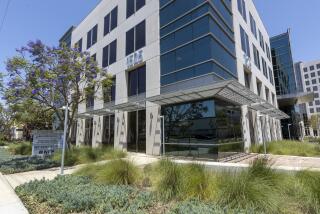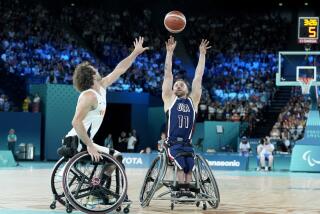Disabled ‘Better Off, but . . . a Long Way to Go’
Dale Elizabeth Garcia had little sense of the daily, tedious frustrations faced by disabled people until her daughter Allison was born with cerebral palsy 15 years ago. She learned quickly.
She and Allison were denied the mother-daughter ritual of shopping because the wheelchair would not fit down market aisles.
Waitresses asked her in furtive whispers to please refrain from feeding Allison in public because it disturbed the patrons.
Still, Garcia and other people in Orange County who work with the disabled see reason for optimism.
Seven years after the Americans with Disabilities Act mandated civil rights and equal access for millions of physically challenged people, they are noticing improvements in both opportunities and public attitudes.
Advances in technology, especially in the realm of computers, have opened the working world to many disabled, experts said.
Laws that prohibit discrimination are helping, they add.
“It just seems like people stare less,” Garcia said. “Maybe we’re not such an oddity now because of all the efforts to get people out in the community more. It certainly seems there are more accommodations.”
Other agreed but stress that the disabled still face many barriers.
“My personal opinion is that the disabled are better off, but we’ve got a long way to go,” said Tom Burns, chief of research and statistics for the state’s Department of Rehabilitation.
“Most people with disabilities feel their biggest barrier is other people’s attitude,” he added. “One of the assumptions is that they don’t have a life. You can list 100 ways they are the same as everybody else. But some people don’t do that. Those attitudes are horribly punishing.”
In some cases, advocacy groups are helping disabled people overcome community fears and receive the services they need.
The Braille Institute of Orange County, which serves about 1,500 people at its Anaheim center and hundreds more in outreach centers around the county, is getting around the perennial transportation problem by sending teachers and trainers into communities.
The biggest advances for the blind, as for other disabled people, have come in technology, said institute director Sheila Daily.
New devices allow the blind to take notes in Braille and have them read back in voice. They can use e-mail and the Internet, helping them find and keep jobs. Recorders for special books-on-tape, a staple of the community since the 1930s, are easier to handle and less cumbersome.
Jim Ellison, a 28-year-old graduate of UC Riverside who has been in a wheelchair since birth, knows what he wants to do. He has a degree in business administration and is studying technical writing.
If Ellison gets a job, he will lose his government aid. Because he has cerebral palsy, he said he needs to find a job with a good salary and benefits.
Ellison’s wheelchair costs $15,000. He requires a home attendant, and a voice-activated computer system is crucial.
“I would like to work and be independent and make a decent living,” said Ellison, who relies on Access, the Orange County Transportation Agency’s special bus service for the disabled. “Access works pretty well, but I have to call a week in advance.”
*
Gregg Brown, a 34-year-old Costa Mesa resident with cerebral palsy, persuaded the city to enhance curb cuts in sidewalks and prolong traffic lights to allow more time for people to cross the street.
He moved into a group home, received a customized wheelchair and a state-of-the-art communication device and now attends classes at Orange Coast College.
Brown found a job helping to clean litter off Newport Beach’s Balboa Pier.
“I love working near the beach,” he said. “Yes, there are definitely improvements.”
More to Read
Sign up for Essential California
The most important California stories and recommendations in your inbox every morning.
You may occasionally receive promotional content from the Los Angeles Times.










